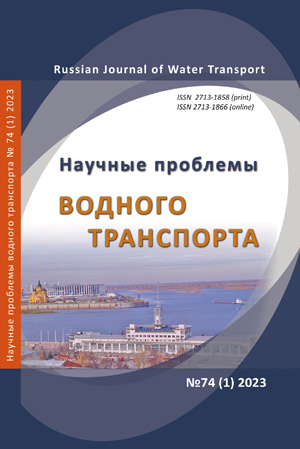Methodological approach to assessing the effectiveness of the logistics infrastructure
Abstract
Today, in a rapidly changing external environment, one of the main factors for improving the work of a port operator is the development of its logistics infrastructure. Under the current conditions, the process of managing the logistics infrastructure of a port operator should be complex and interdependent, which determines the need to use a systematic approach. The existing methods of managing the infrastructure facilities of the port are poorly adapted to industry specifics, built on a limited number of parameters, do not allow for an operational and comprehensive assessment of the level of infrastructure use with the identification of problem areas. We need an approach to logistics infrastructure management that will allow us to simultaneously effectively solve current tasks, flexibly reconstructing after the production program of the port and, at the same time, take into account the long-term development of its facilities. The practical significance of the study lies in the possibility of applying the developed methodology for assessing the effectiveness of logistics infrastructure service management in order to optimize port activities. The obtained research results will allow us to monitor the current use of the logistics infrastructure of the port operator quantitatively and qualitatively, identify bottlenecks and, based on such calculated information, justify further areas of improvement and development.
References
PortNews [Электронный ресурс]. – Режим доступа: http://portnews.ru/news/277473/ (дата обращения 19.10.2022).
Болодурина М.П. Концептуальные основы формирования и развития транспортно-логистической инфраструктуры // Национальные интересы: приоритеты и безопас-ность. 2019. – Т. 15. №2. – С. 240-257.
Костров В.Н. Государственное регулирование и развитие портовой инфраструктуры: российский и европейский опыт // Экономика и общество. 2019. №9(13). [Электрон-ный ресурс]. – Режим доступа: https://scipress.ru/economy/articles/gosudarstvennoe-regulirova-nie-i-razvitie-portovoj-infrastruktury-rossijskij-i-evropejskij-opyt.html (дата обра-щения: 20.10.2022).
Артамонова М.Ю., Костюченко Т.Ю. Особенности и проблемы управления логистиче-ской инфраструктурой стивидорных операторов России // Вестник государственного морского университета имени адмирала Ф.Ф. Ушакова. 2021. №4 (37). С. 20-25. [Элек-тронный ресурс]. – Режим доступа: https://aumsu.ru/images/vestnik/pdf/Vestnik_4_37.pdf (дата обращения 15.10.2022).
Мерзлов И.Ю. Комплексная методика оценки уровня цифровизации организаций // Экономика, предпринимательство и право. 2020. – Т. 10. – №9. – С. 2379-2396. https://doi.org/10.18334/epp.10.9.110856
Добровольская К.А. Оценка эффективности логистической инфраструктуры и факто-ры, ее определяющие // Инновационная наука. 2019. – №12. – С. 208-211.
Наша задача – превратить российские порты в современные гавани // Морские порты. 2019. – №7. [Электронный ресурс]. Режим доступа: https://plus.rbc.ru/news/5d19c 9527a8aa94 bc1aece59 (дата обращения: 14.10.2022).
Лепехина Ю.А., Грасс Е.Ю. Формирование показателей для оценки эффективности функционирования транспортного холдинга. Материалы Международного форума «Свобода и ответственность в переломные времена» (FaR), 19-23 апреля, Нижний Новгород. 2021. – С. 721-732. [Электрон. ресурс]. – Доступно по адресу: https://www.europeanproceedings.com/book-series/EpSBS/books/vol125-far-2021 (дата об-ращения 12.12.2022).
Ботнарюк М.В., Классовская М.И. Определение значимости индикаторов достижения целей при построении системы управления предприятий транспортной отрасли в цифровой экономике // Морские интеллектуальные технологии. 2021. №2-4(52). – С. 146-152. https://doi.org/10.37220/MIT.2021.52.2.084
Жулева О.И., Кузьменкова В.Н. Логистические инновации и анализ деятельности российских морских портов, динамика грузооборота и перспективы развития // Вест-ник Алтайской академии экономики и права. 2019. № 2-2. С. 260-266.
Copyright (c) 2023 Russian Journal of Water Transport

This work is licensed under a Creative Commons Attribution 4.0 International License.













